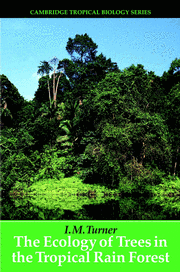2 - The growing tree
Published online by Cambridge University Press: 24 November 2009
Summary
Trees: form, mechanics and hydraulics Tree stature
Individual trees of a large range of size are to be found in the tropical rain forest (see the profile diagram in Fig. 2.1). Each tree species also has a characteristic size at maturity and species are often referred to various stature classes, such as understorey trees, canopy trees and emergents, but, as Figure 2.2 shows, there is no discrete clustering of species in size classes. Maximum diameter for species on 50 ha in Pasoh Forest, Peninsular Malaysia (Fig. 2.2), was approximately a truncated log-normal distribution with a modal class in the 10–20cm maximum dbh range. A breakdown of species into height classes (Table 2.1) shows about half of the tree species to have maximal heights of 20m or less. The tallest trees at Pasoh probably reach to about 60m in height, showing that the community of understorey specialists in the forest is as rich in tree species as that of the canopy, and is definitely richer on a unit depth basis. A similar pattern is seen in the forest at La Selva, Costa Rica (Hartshorn 1980), and on Barro Colorado Island, Panama (Hubbell & Foster 1992).
The vertical distribution of tree species diversity in the forest may reflect the relative illumination at different heights above the forest floor. At Pasoh, relative illumination increases logarithmically with height (Fig. 2.3). The understorey species in the bottom 20m of the forest rarely receive more than 5% of the radiation arriving at the top of the canopy.
- Type
- Chapter
- Information
- The Ecology of Trees in the Tropical Rain Forest , pp. 15 - 102Publisher: Cambridge University PressPrint publication year: 2001

